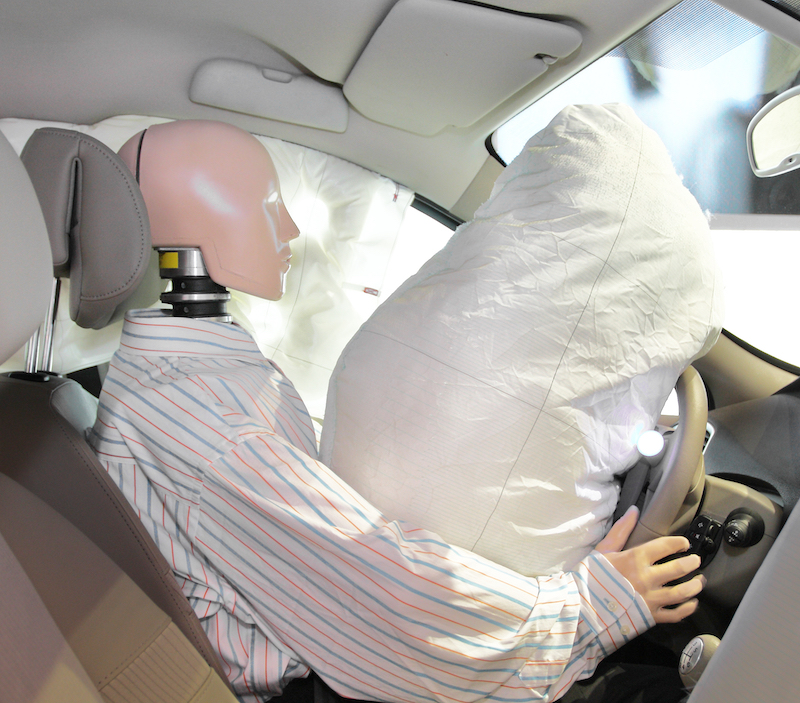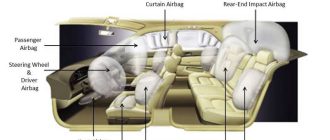
What Happens When Airbags Deploy During an Accident
When it comes to car accidents, the safety of drivers and passengers is of utmost importance. One crucial safety feature that plays a significant role in minimizing injuries is the deployment of airbags. These sophisticated devices are designed to inflate almost instantly during a collision, providing a cushioning effect that can prevent occupants from impacting the interior of the vehicle.
So, what happens when airbags deploy during an accident? The deployment of airbags occurs in a fraction of a second, triggered by a series of sensors that detect rapid deceleration, changes in direction, or impact force. Once deployed, the airbags create a barrier between the occupants and hard surfaces, such as the steering wheel or dashboard, reducing the risk of severe head, chest, and limb injuries.
During a collision, the force exerted on the body can be immense. The sudden deceleration can cause various injuries, from whiplash and fractures to blunt trauma. Airbags deploy to absorb some of this energy and dissipate it more evenly across the body. This can help prevent or minimize injuries to the head and chest, which are especially vulnerable during a frontal impact.
While the deployment of airbags is instrumental in reducing injuries, it’s important to note that their effectiveness depends on proper seatbelt use. Airbags are designed to work in conjunction with seatbelts, which secure the occupant in place. Together, these safety systems provide the best possible protection during a collision and help reduce the risk of severe injuries or fatalities.
The Role of Airbags in Vehicle Safety
Airbags play a crucial role in vehicle safety, especially during accidents. When an accident happens, airbags are designed to deploy and provide an additional layer of protection for the occupants of the vehicle. They are specifically designed to reduce the risk of serious injury or even death during a collision.
During an accident, the force of impact can cause the occupants to be thrown forward or to the side. This sudden movement can lead to severe injuries, particularly to the head, chest, and upper body. Airbags are strategically placed within the vehicle to help mitigate the impact forces and reduce the risk of such injuries.
When airbags deploy, they quickly inflate with gas, creating a cushioning effect. This cushioning effect helps to absorb the impact and distribute the force more evenly across the body. It not only protects the occupants from hitting hard surfaces within the vehicle, such as the dashboard or steering wheel, but also helps to prevent the occupants from being ejected from the vehicle.
It is important to note that wearing seatbelts in conjunction with airbags is crucial for maximum safety during an accident. Seatbelts hold the occupants in place, preventing them from being thrown forward or out of the vehicle. Airbags, on the other hand, provide an additional layer of protection by acting as a supplemental restraint system.
Overall, the deployment of airbags during an accident significantly reduces the risk of severe injuries and fatalities. They are designed to work in tandem with seatbelts to provide the best possible protection for the occupants. Understanding the role of airbags and their importance in vehicle safety is essential for all drivers and passengers.
The Mechanism of Airbags and Their Importance in Vehicle Safety
When an accident occurs, the importance of airbags becomes apparent. These safety devices are designed to deploy during a collision and serve as a protective cushion for the vehicle occupants.
So, what happens when airbags deploy during an accident? The mechanism of airbags is quite simple yet crucial for vehicle safety. When a collision is detected, a sensor sends a signal to the airbag control unit. This unit then triggers the deployment of the airbags.
Upon deployment, the airbags inflate rapidly, usually within milliseconds. They are designed to quickly fill the space between the occupant and the hard surfaces of the vehicle, reducing the impact of the collision and preventing severe injuries.
The deployment of airbags can help protect the occupants from hitting their head on the steering wheel, dashboard, or windshield. It can also prevent them from forcefully striking other passengers or objects inside the vehicle.
Airbags primarily work in conjunction with seat belts to maximize safety. While seat belts help restrain the occupants, airbags provide an additional layer of protection by distributing the forces of the collision more evenly across the body.
The importance of airbags in vehicle safety cannot be overstated. According to studies, airbags have been effective in reducing the risk of fatalities and severe injuries in frontal crashes. They can greatly minimize the impact forces on the head, neck, and chest, which are more prone to serious injuries during an accident.
However, it is important to note that airbags are not without their limitations. They are designed to be used in combination with seat belts and are most effective in frontal crashes. Side impacts or accidents from other angles may not trigger airbag deployment or provide the same level of protection.
In conclusion, airbags play a critical role in vehicle safety. When they deploy during an accident, they provide a cushion and help reduce the impact forces on the occupants, preventing severe injuries. However, it is important to remember that airbags are just one part of the overall safety system, and utilizing seat belts correctly is also crucial for maximum protection.
The Purpose of Airbags in Reducing Injuries
When an accident happens and a collision occurs, the airbags in a vehicle deploy to help protect the occupants. Airbags are designed to quickly inflate and provide a cushioning effect between the occupant and the hard surfaces of the vehicle.
Airbags are an essential safety feature that can greatly reduce the severity of injuries sustained during a collision. They work in conjunction with seat belts to provide optimum protection to the occupants. When airbags deploy, they help to distribute the force of the impact and minimize the risk of serious injuries to the head, chest, and other vulnerable areas.
During a collision, the airbags deploy in a matter of milliseconds, thanks to sensors that detect the sudden deceleration or impact. Once the sensors are triggered, the airbags are filled with gas to create a cushioning effect. The purpose of this rapid deployment is to prevent the occupants from forcefully hitting the steering wheel, dashboard, windshield, or other hard surfaces inside the vehicle.
Airbags are particularly effective in reducing the risk of head injuries. When a collision occurs, the airbag inflates between the occupant’s head and the front window, providing a barrier that helps prevent direct contact with the glass. This can help reduce the risk of traumatic brain injuries and other head-related injuries.
It is important to note that airbags are most effective when used in combination with seat belts. Seat belts help to keep the occupants in a proper position and prevent them from being thrown forward during a collision. The combination of airbags and seat belts can significantly reduce the risk of severe injuries or even fatalities.
Overall, the purpose of airbags is to minimize the impact forces on the occupants during a collision and reduce the risk of injuries. They are a crucial safety feature in modern vehicles that aim to provide a safer driving experience for everyone on the road.
How Airbags Deploy in an Accident
When an accident occurs, the deployment of airbags is a crucial safety feature that can help protect vehicle occupants from serious injuries. Airbags are designed to rapidly inflate and then deflate upon impact, providing a cushion between the occupant and the hard surfaces of the vehicle.
The process of airbag deployment is triggered by sensors that detect the force of impact. When a significant collision is detected, a signal is sent to the airbag system, which then activates a chemical reaction. This reaction generates a gas, usually through the use of sodium azide, which rapidly fills the airbag within milliseconds.
Once the airbag is fully inflated, it acts as a barrier between the occupant and the hard surfaces of the vehicle, absorbing the energy of the impact and reducing the risk of head, neck, and chest injuries. The airbag deflates immediately after deployment to allow the occupant to move freely and exit the vehicle.
The Sensors that Trigger Airbag Deployment
When an accident occurs, the airbags in a vehicle play a crucial role in protecting the occupants. But what happens in the split second before the airbags deploy?
Airbags deploy when specific sensors detect a collision or a sudden deceleration during an accident. These sensors are strategically placed throughout the vehicle to ensure accurate detection. The primary sensors responsible for airbag deployment are the crash sensors, also known as accelerometers.
Crash sensors are designed to measure the rate of deceleration of the vehicle, typically in the event of a frontal collision. They are capable of sensing the sudden change in velocity and transmitting the information to the airbag control unit. This information is then processed by the control unit to determine if the airbags should be deployed.
The crash sensors are highly sensitive and are calibrated to trigger the airbags only in the event of a severe impact. They are designed to filter out false triggers, such as hitting a pothole or a minor fender bender. This ensures that the airbags deploy only when necessary and prevents unnecessary deployment.
In addition to the crash sensors, some vehicles have additional sensors that provide supplementary information to the airbag control unit. These sensors may include side impact sensors, rollover sensors, and seat belt tension sensors. These sensors help the control unit make more informed decisions about airbag deployment based on the specific nature of the accident.
Overall, the sensors responsible for triggering airbag deployment during an accident are carefully designed to accurately detect and evaluate the severity of the impact. By doing so, they help protect the occupants of the vehicle and mitigate the potential injuries that may occur.
Understanding the Speed and Force of Airbag Deployment
When an accident occurs and airbags deploy, it is important to understand the speed and force at which this happens. Airbags play a crucial role in ensuring the safety of drivers and passengers during a collision.
The deployment of airbags is a rapid and powerful event. The speed at which airbags deploy can reach up to 200 miles per hour. This instant inflation is necessary to provide an immediate cushioning effect and prevent occupants from hitting hard surfaces inside the vehicle.
The force generated by airbag deployment is also significant. The force can range from 1,000 to 2,000 pounds, depending on the type of airbag and the severity of the collision. This force is crucial in restraining the forward movement of occupants and reducing the risk of severe injuries.
During an accident, sensors located throughout the vehicle detect the impact and send signals to the airbag control module. The module then activates the airbag system, which triggers the deployment of the airbags. The entire process, from impact detection to airbag deployment, happens within milliseconds.
It is important for drivers and passengers to understand the speed and force of airbag deployment to fully appreciate the importance of wearing seat belts. Seat belts are designed to work in conjunction with airbags and help minimize the risk of injuries during a collision.
Overall, the speed and force of airbag deployment during an accident are critical factors in ensuring the safety of vehicle occupants. Understanding these factors can help people appreciate the importance of airbags and the need to always wear seat belts.
The Impact of Airbag Deployment on Occupants

When an accident happens and airbags deploy, the impact on the occupants can be significant. Airbags are designed to rapidly inflate upon impact, providing a cushioning effect between the occupants and the interior components of the vehicle. This rapid inflation and deployment can help to prevent more severe injuries by reducing the force of impact and keeping the occupants from striking hard surfaces.
Airbags deploy in milliseconds, faster than the blink of an eye. This rapid deployment can initially cause a loud noise and a sudden burst of pressure, which can startle occupants. However, this brief moment of intensity is a necessary trade-off for the protective benefits that airbags provide.
During an accident, airbags can help to reduce the risk of head and neck injuries by cushioning the impact and preventing occupants from hitting the steering wheel, dashboard, or windshield. They also provide protection for the chest and torso, helping to prevent rib and internal injuries.
It is important for occupants to be properly positioned and wearing their seatbelts to fully benefit from airbag deployment. The force of the deploying airbag can be powerful, and an occupant who is too close or not properly restrained can be at risk of injury from the airbag itself. It is crucial to always follow proper safety precautions while driving and adjust the position of the seat and steering wheel to minimize the risk of injury.
In conclusion, when airbags deploy during an accident, they play a crucial role in minimizing the impact on occupants. By rapidly inflating and providing a cushioning effect, airbags help to reduce the risk of serious injuries to the head, neck, chest, and torso. However, it is important for occupants to be properly positioned and restrained to fully benefit from airbag deployment. By following proper safety measures, occupants can increase their chances of staying safe and minimizing injuries in the event of an accident.
The Protection Provided by Airbags in Frontal Collisions
Airbags are designed to provide critical protection during frontal collisions by deploying rapidly when a crash occurs. When an accident happens, the airbags are triggered to deploy within milliseconds, forming a cushion between the occupants and the hard surfaces of the vehicle. This rapid deployment helps to reduce the severity of injuries that may be caused by the impact.
During a collision, the airbags provide a barrier between the occupants and the interior of the vehicle, absorbing some of the forces generated by the crash. This can help to prevent occupants from striking hard surfaces such as the steering wheel, dashboard, or windshield. The rapid inflation and subsequent deflation of the airbags also help to slow down the forward motion of the occupants, minimizing the risk of injury.
When airbags deploy during a frontal collision, they typically come out from the steering wheel for the driver and the dashboard for the front passenger. The force of the airbag deployment can be quite powerful, reaching speeds of up to 200 miles per hour. However, the energy of the deployment is carefully controlled and distributed to provide maximum protection while minimizing the risk of injury from the airbag itself.
In addition to cushioning the impact, airbags also work in conjunction with seat belts to improve safety. While seat belts are designed to prevent occupants from being thrown forward during a collision, airbags complement this protection by providing an extra layer of cushioning and restraint.
It is important to note that airbags are specifically designed to provide protection during frontal collisions. They are not meant to deploy during other types of accidents, such as side impacts or rollovers. The sensors in the vehicle are programmed to detect the specific conditions that indicate a frontal collision, ensuring that the airbags are only deployed when necessary.
Overall, airbags play a crucial role in mitigating the impact of frontal collisions by providing a protective barrier between the occupants and the interior of the vehicle. Their rapid deployment and controlled inflation help to absorb the forces generated by the crash and reduce the risk of severe injuries. When used in conjunction with seat belts, airbags significantly enhance the safety of occupants during accidents.
The Potential Risks and Injuries Associated with Airbag Deployment
Airbags are an essential safety feature in vehicles that can protect occupants during accidents. However, it is essential to understand that airbag deployment can lead to potential risks and injuries.
- During an accident, airbags deploy at high speeds, often within milliseconds. The force of this deployment can cause injuries to the occupants.
- The primary purpose of an airbag is to prevent the occupants from hitting hard surfaces like the steering wheel or dashboard. However, the force of impact can still cause bruises, abrasions, and even fractures.
- When an airbag deploys, it releases chemicals such as sodium azide, which can cause respiratory issues and skin irritations.
- In rare cases, airbags can malfunction, either not deploying during an accident or deploying suddenly without any apparent reason. These malfunctions can lead to injuries or accidents.
It is crucial to understand that while airbags provide significant protection, there are potential risks and injuries associated with their deployment during an accident. Proper usage of seat belts and exercising caution while driving can help mitigate these risks.
Proper Use and Maintenance of Airbags
Airbags are an essential safety feature in vehicles that can significantly reduce injuries during an accident. Understanding how to properly use and maintain airbags is crucial for ensuring their effectiveness when they deploy.
When an accident happens and airbags deploy, it’s important to remember that they are designed to work in conjunction with seat belts. Airbags alone are not enough to prevent injuries or provide adequate protection. Therefore, it’s essential to always wear seat belts properly and securely even when vehicles are equipped with airbags.
During an accident, airbags deploy rapidly, inflating within milliseconds to provide cushioning and prevent occupants from hitting hard surfaces. This rapid deployment can result in loud noises, a sudden rush of air, and a release of dust particles. It’s crucial to stay in an upright position and maintain a safe distance from the airbag when it deploys, as contact with the deploying airbag can cause injuries.
Proper maintenance of airbags is also necessary to ensure their effectiveness. Regularly checking the airbag warning light on the vehicle’s dashboard is crucial, as it indicates if there’s a problem with the system. Any issues should be addressed promptly by a qualified technician to ensure proper function.
It’s also important to keep the areas around the airbag clear and free of any obstructions. Objects that obstruct the airbag’s deployment path can affect its effectiveness during an accident. Therefore, avoid placing items on the dashboard or hanging accessories from the sun visors.
In conclusion, airbags are a vital safety feature in vehicles that can significantly reduce injuries during an accident. Proper use and maintenance of airbags ensure their effectiveness when they deploy. Remember to always wear seat belts correctly and maintain a safe distance from the airbag when it deploys. Regularly check the airbag warning light and keep the areas around the airbag clear to ensure their proper functioning. By following these guidelines, you can maximize the safety benefits provided by airbags in your vehicle.
Ensuring Airbags are Functioning Properly and Not Tampered With
When it comes to the safety of both drivers and passengers, it is crucial to ensure that airbags are functioning properly and have not been tampered with. When airbags deploy during an accident, they provide a cushioning effect that helps to minimize the impact of the collision and reduce the risk of serious injury.
In order to ensure that airbags are functioning properly, it is important to have them regularly inspected and maintained by a qualified professional. This includes checking the sensors, connections, and overall condition of the airbag system. Regular maintenance can help to identify any issues or malfunctions before they become a safety concern.
In addition to regular inspections, it is also important to ensure that airbags have not been tampered with. Tampering with the airbag system can involve disabling, removing, or interfering with the sensors or connections. This can significantly impact the effectiveness of the airbags during an accident and put the occupants at a higher risk of injury.
To prevent tampering, it is recommended to keep the airbag system intact and avoid any modifications or alterations that are not approved by the manufacturer. If any modifications or repairs are necessary, they should be carried out by a qualified technician who has the proper knowledge and expertise to work with airbags.
Furthermore, it is important to be cautious when purchasing a used vehicle. It is essential to thoroughly inspect the airbag system to ensure that it has not been tampered with or compromised. This includes checking for any signs of previous repairs or alterations and verifying the vehicle’s history to ensure that it has not been involved in any accidents or incidents that could have affected the airbags.
Overall, ensuring that airbags are functioning properly and have not been tampered with is crucial for the safety of everyone inside the vehicle. Regular inspections and maintenance, avoiding unauthorized modifications, and being cautious when purchasing a used vehicle can help to ensure that airbags will deploy effectively during an accident and provide the necessary protection.
Replacing and Resetting Airbags After Deployment
When an accident occurs and airbags deploy, it is crucial to understand what happens to them and what steps need to be taken afterwards.
During a collision, airbags deploy rapidly to protect the occupants of a vehicle. The deployment is triggered by sensors that detect the impact and send signals to the airbag module. When the airbags deploy, they fill with gas within milliseconds, creating a cushioning barrier between the occupants and the hard surfaces of the vehicle.
Once the airbags have deployed, they cannot be reused. They must be replaced with new ones to ensure the safety of the vehicle. Replacing the airbags should be done by a trained professional, as it involves handling explosive materials and precise installation procedures. It is important to follow the manufacturer’s guidelines and use genuine airbag components to maintain the effectiveness of the safety system.
Resetting the airbag system is another step that needs to be taken after airbag deployment. The airbag control module, which is responsible for the deployment of the airbags, stores crash data and fault codes. These need to be cleared to ensure that the system is ready to deploy new airbags in case of another accident. Resetting the airbag system should also be performed by a professional using specialized diagnostic equipment.
It is worth noting that the cost of replacing and resetting airbags can be significant, depending on the vehicle make and model. However, it is essential to prioritize safety and ensure that the airbag system is functioning properly. Neglecting these steps can put occupants at risk in case of another collision.
Question-answer:
What is the purpose of airbags in a car?
The purpose of airbags in a car is to provide an additional layer of protection for the occupants in the event of a collision. When a collision occurs, the airbags are designed to quickly inflate and act as a cushion to absorb the impact and prevent or reduce injuries.
How do airbags deploy during an accident?
Airbags deploy during an accident based on signals from sensors located throughout the vehicle. These sensors detect rapid deceleration or impact, triggering the airbag system to deploy. It typically takes just a fraction of a second for the airbags to inflate and provide protection to the occupants.
Do airbags always deploy in every accident?
No, airbags do not always deploy in every accident. The deployment of airbags depends on certain factors such as the severity and angle of the impact. If the accident is of a lower severity or the impact is not directly on the front of the vehicle, the airbags may not deploy. Additionally, some newer vehicles are equipped with advanced airbag systems that can analyze the collision dynamics and selectively deploy specific airbags based on the need.
What are the potential injuries caused by airbag deployment?
The deployment of airbags can cause injuries, especially if the occupant is not wearing a seatbelt or if they are sitting too close to the airbag. Common injuries include burns, abrasions, and fractures. In some rare cases, airbag deployment can also cause more serious injuries such as concussions or internal injuries. However, it is important to note that the potential benefits of airbags in preventing more severe injuries often outweigh the risks of these minor injuries.





